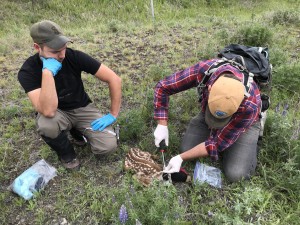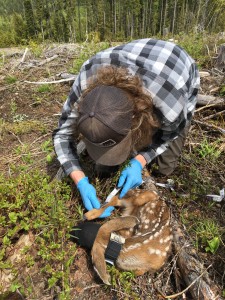The Southern Interior Mule Deer (SIM Deer) Project is an ongoing, collaborative multi-year project covering an area roughly the size of a small country in order to collect scientific data on why SIM deer populations are decreasing. The project is a collaboration with the Okanagan Nation Alliance, The University of BC Okanagan, The University of Idaho and the British Columbia Fish and Wildlife Branch.
The project has a total of 225 camera sites and over 800,000 mapped SIM deer locations (from collared deer) across 30,000 square kilometres, in West Okanagan, Boundary and Cache Creek regions.
The study is unique because the camera trap and collaring data together should provide insight on how highly complex animal interactions and different human-caused landscape disturbances may be negatively affecting the Southern Interior mule deer population.
Human-caused landscape disturbances include: unusually high density of secondary roads in the Southern Interior of B.C., changes in fire patterns with significantly fewer low-intensity fires in the area (fires are often followed by higher quality forage), cut blocks and more.
Next year preliminary results from our extensive trap camera research should be available, and by late 2023 the data analysis of collared deer migration, survival, and mortality should be complete.
Capture and Collar
We are meeting our collaring goals for all deer age groups and have collected over 800,000 locations, mapping the movement of females and juveniles between summer and winter ranges and landscape features. In the last year, 137 additional adults and fawns have been captured and collared. We have added: 6 adults, 18 fawns and 21 neonates to the West Okanagan study area; 3 adults, 19 fawns and 20 neonates in the Boundary study area; and 12 adults, 18 fawns and 20 neonates to the Cache Creek study area. Since the program began three years ago, 382 deer have been collared (including deer whose collars failed or fell off as designed).
We incorporated collaring of neonates into the project more recently. Historically, the technology required for capturing and collaring neonates was prohibitively expensive, but we have implemented very recent methodology in neonate collaring, allowing the project to collect survival data on neonates much more affordably. Data on survival of neonates allows us to more accurately estimate one-year survival rates. The data also helps determine how maternal winter and summer range affects neonate survival (how landscape affects neonate survival).
Survival and Mortality
So far results indicate adult survival rates are different by region but not by year. To date we have investigated 155 mortalities. Annual adult female survival for the last three years in the West Okanagan was 85%, Boundary was 75%, and Cache Creek was 86%. Average fawn survival for the last three years from December to June in West Okanagan was 64%, in Boundary was 66%, and in Cache Creek was 63%. However, overwinter fawn survival differs by region and significantly by year, and more data is being collected to analyse why fawn survival varies significantly from year to year.
The collars notify us if a deer has been stationary for 4-6 hours, indicating a mortality. We try to reach that collar location within 48 hours and complete a mortality investigation. If the reason for mortality is clear, we record the cause of death and collect the jaw and femur to estimate body condition and age of the deer when it died. If there is no obvious reason for death (i.e. no predator sign in the area), we conduct either a field or lab necropsy. Deaths are only recorded as “unknown” if there are almost no remains, and no other evidence to establish probable cause of death.
All female adult and 6-month-old fawn mortalities since the start of the project:
Mortality Cause Number
| Accident | 1 |
| Black Bear | 2 |
| Canid | 6 |
| Cougar | 42 |
| Coyote | 8 |
| Drowning | 1 |
| Grizzly Bear | 1 |
| Harvest | 2 |
| Health | 2 |
| Probably Cougar | 8 |
| Predation | 2 |
| Probable Bear | 1 |
| Probable Coyote | 7 |
| Probably Wolf | 1 |
| Starvation | 2 |
| Unknown | 15 |
| Vehicle | 5 |
| Wolf | 6 |
All neonate mortalities from the first 15 weeks of life (not included in the above table):
Mortality Cause Number
| Bear | 10 |
| Black Bear | 3 |
| Cougar | 1 |
| Exposure | 1 |
| Health | 2 |
| Lynx spp | 1 |
| Probably coyote | 1 |
| Predation | 3 |
| Probably Bear | 5 |
| Probably Cougar | 1 |
| Unknown | 15 |
| Harvest | unknown |
It is possible to look at these numbers and blame predators for deer population decline, but research shows that in regions of North American where there are no predators, survival numbers are very similar (please watch our Mule Deer Webinar from November 2020).
Camera Trapping
We are working with over 300 volunteers to service and analyze data from over 200 camera sites. And while we have reached our goal of gathering 3 years of data, due to popular demand, this fall the camera project will continue into its fourth year! Right now we are in the process of gathering the final round of SD cards from our cameras to use in our analyses, which will include photos taken from 2019-2022. After all the cards have been turned in, we will look to citizen scientists to help us review the photos and identify species. Once our collection of photos has been catalogued, we will use the dataset to determine how factors like wildfires, logging, roads, and people influence mule deer occurrence and activity patterns in southern B.C., as well as the biodiversity of large mammals in this region.
If you’d like to help and enjoy looking at pictures of wildlife, please send an email to samuelfoster@uidaho.edu to help sort the three million photos of wildlife taken by our cameras.
To donate, visit BCWF Ways to Give and select ‘Southern Interior Mule Deer Project’ under designation, and we will issue you a tax receipt.
Thanks
The Southern Interior Mule Deer Projects is the largest collaborative wildlife research project in British Columbia. It would not happen without our collaborators, funders and volunteers. This year, we especially want to thank Brian Hancock, David Carleton and Grant Hiebert for their work coordinating 100 volunteers.


